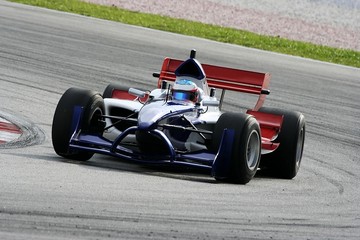Subscriber Benefit
As a subscriber you can listen to articles at work, in the car, or while you work out. Subscribe NowWriter Kate Wagner may have seemed like an odd choice to cover the luxury world of Formula One.
A socialist who’s painfully self-conscious about class differences, Wagner skewers expensive homes on her blog McMansion Hell and writes about architecture for the left-wing magazine the Nation.
Formula One races, meanwhile, have become pit stops on the jet-set circuit, where the cheapest general-admission tickets start around $500. Still, Road & Track magazine commissioned Wagner to cover a Formula One race in Austin last fall, sending her on a trip funded by British petrochemicals company INEOS.
Her resulting 5,000-word story has drawn praise since it was published Friday, largely because of the unlikely pairing of writer and subject. “Even better than what you’re imagining,” the conservative website the Bulwark gushed. Former CNN host Brian Stelter heralded it as “a joy to read.”
While Wagner wrote appreciatively about the sport’s aesthetics and superstar driver Lewis Hamilton’s “aura,” she also dissected the crowd of “tech bros” and “Ozempic-riddled influencers” that surrounds the sport.
“People clinked glasses of free champagne in outfits worth more than the market price of all the organs in my body,” she wrote.
Anyone who wants to read it, though, won’t be reading it on Road & Track’s website. Roughly an hour after it was published, “Behind F1’s Velvet Curtain” vanished without an explanation.
In its absence, admirers have resorted to sharing an archived version that seems to have gone viral in media circles—many noting, as did New Yorker food writer Helen Rosner, that it had been “mysteriously removed.”
It’s almost unheard of for a news outlet to retract an article without explanation, especially a story of this size whose accuracy has not been publicly challenged. Neither Wagner nor Road & Track responded to requests for comment.
A person familiar with editorial deliberations at Road & Track said the story, which had been in the works for months, was pulled after its publication at the order of Editor in Chief Daniel Pund on the grounds that it didn’t fit with the site’s editorial goals.
Pund, who was appointed to the magazine’s top job in January after working as the executive editor, was not aware of the story before it was published, according to the person, who spoke on the condition of anonymity to preserve confidences.
It’s possible that Wagner’s piece ruffled more feathers in the automotive industry than the typical Road & Track story. (On its website Tuesday, the lead story’s banner headline declares that the new Dodge Charger “Does It All.”) Wagner’s is the kind of grand, impolite story that is increasingly rare in the struggling magazine industry, where surviving outlets depend on not offending the advertisers or celebrities they feature.
The author criticized the general state of Formula One, arguing that it has grown boring amid the dominance of Red Bull Racing star Max Verstappen. Wagner also mocked her hosts at INEOS, describing its invitation to her as a bid to gain positive publicity and whitewash the company’s image.
“The petrochemical companies, deeply powerful institutions, need journalists to write about all the things they attach themselves to that are not being a petrochemical company,” she wrote.
INEOS spokesman Richard Longden said the company had no knowledge of what had happened to Wagner’s story.
“We did not know the piece had been published until you told us,” Longden wrote in an email. “We certainly didn’t ask for the article to be removed.”
Wagner also described Hamilton—the top driver for Mercedes until he defected to Ferrari last month—as broadly criticizing the condition of his car.
Bradley Lord, a spokesman for the Mercedes-AMG Petronas team, told The Washington Post that it was unaware of the story and hadn’t complained to the magazine about it.
Please enable JavaScript to view this content.

